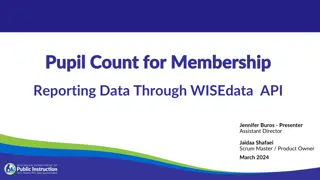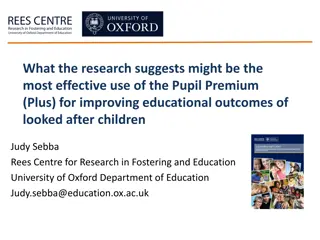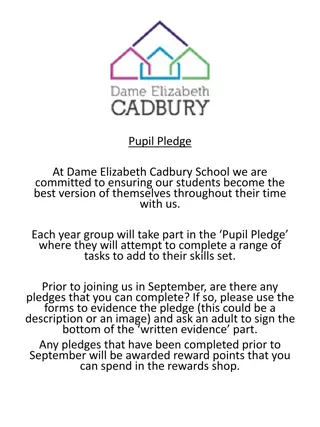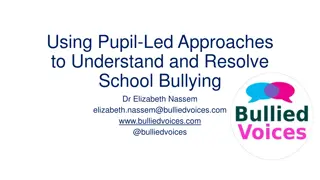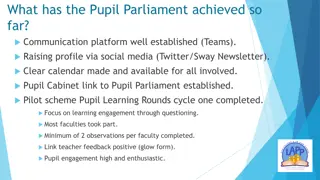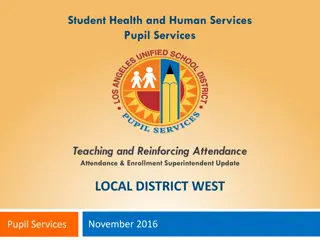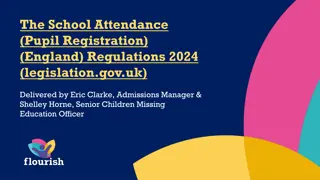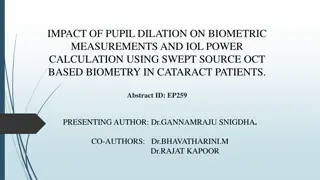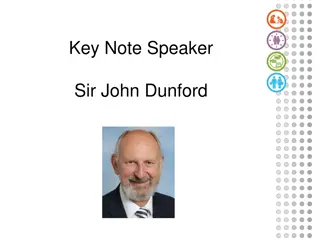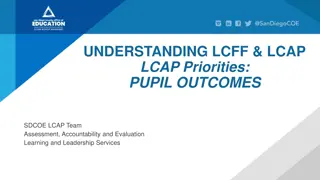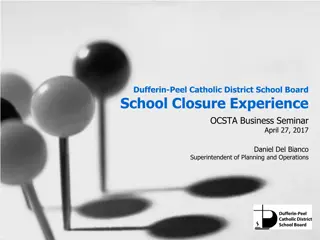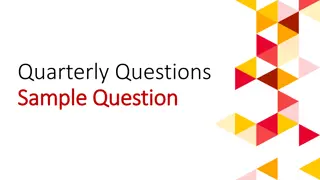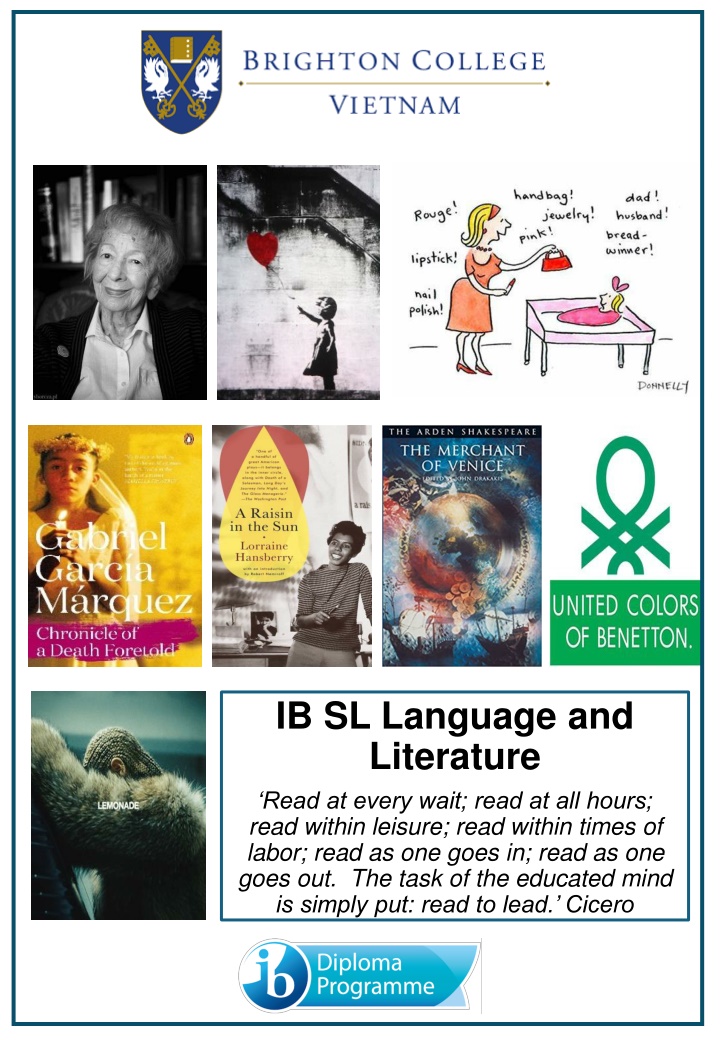
Exploring Key Concepts in IB Language and Literature Course
Delve into the key considerations of imagination, creativity, communication, culture, identity, perspective, representation, and transformation within the IB Language and Literature course. Understand how these concepts shape the interpretation and analysis of texts in a scholarly manner.
Download Presentation

Please find below an Image/Link to download the presentation.
The content on the website is provided AS IS for your information and personal use only. It may not be sold, licensed, or shared on other websites without obtaining consent from the author. If you encounter any issues during the download, it is possible that the publisher has removed the file from their server.
You are allowed to download the files provided on this website for personal or commercial use, subject to the condition that they are used lawfully. All files are the property of their respective owners.
The content on the website is provided AS IS for your information and personal use only. It may not be sold, licensed, or shared on other websites without obtaining consent from the author.
E N D
Presentation Transcript
IB SL Language and Literature Read at every wait; read at all hours; read within leisure; read within times of labor; read as one goes in; read as one goes out. The task of the educated mind is simply put: read to lead. Cicero
Course overview Paper 1 The Language Paper Paper 2 The Literature Paper 2 hours and 15 minutes 1 hour 45 minutes 35% SL 35% SL A choice of two non-literary passages from two different text types. A guiding question will be included to respond to. Four general questions A comparative essay based on two literary works studied in the course. A separate analysis of each of the passages. Individual Oral A prepared individual oral 10 minute presentation with 5 minutes then allocated to questions. 30% SL A presentation analyzing a literary work and a non-literary body of work in relation to the global issue present in both. The Learner Portfolio: The Learner Portfolio acts as a reflection space as well as a space to practise and develop the skills needed for the different component parts of the IB. It also is an area to collate extra reading and further study.
Key concepts within the IB programme Key considerations: What role does imagination play in the act of writing? How far does a reader s own imagination help to generate a range of potential meanings that are above and beyond established interpretations and how important is this? How important or desirable is it that a text is original? Creativity Key considerations: How does a writer communicate with their reader? How do writers make choices of style and structure to enhance this communication? What assumptions might a writer make about a reader s knowledge or views if they have a particular audience in mind? To what extent is a reader s engagement with the text important in order for communication to take place? Communication Key considerations: How does a text relate to its context of production and reception and to the respective values, beliefs and attitudes prevalent in them? What relationship exists between an individual text and the writing traditions that precede it? To what extent is the text a product of a particular cultural and literary context and how does it interact with it? Culture Key considerations: What perspective/s what voice/s or what character/s is/are encountered through a text? How far are the views expressed representative of the writer s identity? How are our identities and readers shaped by what we read? How important is the identity we bring to a text on our analysis of the act of reading and interpretation? Identity Key considerations: To what extent to do the perspectives on offer reflect the views of its author? How far do readers own perspectives influence their interaction with a text? How does a variety of perspectives widen the interpretation of a text? How far do the contexts of production and reception influence and shape perspectives? Perspective Key considerations: How far do language and literature represent reality? To what extent do form and structure interact with, and relate to, meaning? Representation Key considerations: How far do texts refer to one another, utilize elements from other texts and transform them to suit a different aesthetic or communicative purpose? How far is the process of reading a text transformative both for the text and the reader? To what extent do personal interpretations transform a text? What impact does a text have on a reader that might lead to action and to the transformation of reality? Transformation
Global issues: Fields of inquiry Areas covered: aspects of family, class, race, ethnicity, nationality, religion, gender and sexuality and the way these impact on individuals and societies. Issues concerning migration, colonialism and nationalism. Areas covered: beliefs and values nurtured in particular societies and the ways they shape individuals, communities and educational systems. Tensions that arise when there are conflicts of beliefs and values and ethics. Areas covered: aspects of rights and responsibilities, the workings and structures of governments and institutions. Hierarchies of power, the distribution of wealth and resources, the limits of justice and the law, equality and inequality, and peace and conflict. Areas covered: aesthetic inspiration, creation, craft and beauty. Shaping and challenging of perceptions through art, and the function, value and effects of art in society. Areas covered: relationships between humans and the environment, implications of technology and media for society, scientific development and progress. Culture, identity and community Beliefs, value and education Power, politics and justice Arts, creativity and imagination Science, technology and environment
Areas of exploration 1. Why and how do we study language and literature? 2. How are we affected by texts in various ways? 3. In what ways is meaning constructed, negotiated, expressed and discovered? 4. How does language use vary among text types and among literary forms? 5. How does the structure or style of a text affect meaning? 6. How do texts offer insights and challenges? 1. How important is cultural or historical context to the production and reception of a text? 2. How do we approach texts from different times and cultures to our own? 3. To what extent do texts offer insight into another culture? 4. How does the meaning and impact of a text change over time? 5. How do texts reflect, represent or form a part of cultural practices? 6. How does language represent social distinction and identities? 1. How do texts adhere to and deviate from conventions associated with literary forms and genres or text types? 2. How do conventions and systems of reference evolve over time? 3. In what ways can diverse texts share points of similarity? 4. How valid is the notion of a classic text? 5. How can texts offer multiple perspectives of a single issue, topic or theme? 6. In what ways can comparison and interpretation be transformative? Readers, writers and texts Time and space Intertextualit y
DP1: Unit 1: How far does the creative production of a text help individuals to express their feelings about the world in which they live? What will I be studying within this unit? SL Literary text The poetry of Wislawa Szymborsak Wis awa Szymborska (1923 2012), a Polish poet, essayist, and Nobel Prize laureate (1996), is renowned for her concise, thought-provoking poetry that blends humor, irony, and deep existential reflection. Her works explore universal themes like human nature, history, memory, and the ordinary moments of life, often with an undercurrent of skepticism and curiosity. Bodies of work Banksy Political cartoons Liza Donnelly is a prominent cartoonist, author, and speaker known for her witty, insightful commentary on societal issues through humor and illustration. Her work often focuses on themes of gender equality, politics, and cultural dynamics, combining humor with a strong social conscience. Banksy exemplifies how art can be used to challenge authority and provoke change. We will explore how art can, therefore, serve not just an aesthetic purpose but also how it can function as a powerful medium for activism and communication. Non-fiction texts Visual texts: cartoons, magazine covers, infographics, instructions, diagrams, maps Assessment Learner Portfolio: Paper 1: Paper 2: Individual Oral: Task 1: Paper 1: Cartoon analysis annotation and key ideas plan (singular cartoon) Task 1: Paper 2 question conceptually driven using a singular poem. Task 1: mini IO - Poetry and art linked to conceptual question above Task 1: graffiti task linked to the promotion of a social issue. Task 2: own cartoon piece linked to a political issue. Task 2: Paper 1: guided analysis (visual texts) intro and singular paragraph Task 3: In what ways can diverse texts share points of similarity?
DP1: Unit 2: How far do text producers have a responsibility to ensure their representation of the world is one that is rooted in reality? What will I be studying within this unit? Literary text The Merchant of Venice by William Shakespeare Antonio, a Venetian merchant, wishes to help his friend get money to impress a rich heiress. But he is forced to borrow the sum from a cynical, abused Jewish moneylender, Shylock, and signs a chilling contract to honour the debt with a pound of his own flesh. An ambiguous, complex and controversial comedy, The Merchant of Venice explores prejudice, marriage, money and the true nature of justice in an unforgiving world. Bodies of work United Colors of Benetton advertising One of the most well-know fashion companies in the world. Their advertising campaigns have always been social talking points and aroused cultural debate. The speeches of Michelle Obama Michelle Obama was the first lady from 2009 to 2017. As first lady, Obama served as a role model for women and worked as an advocate for poverty awareness and education amongst other things. Non-fiction texts Persuasive texts: Appeals, advertisements, websites (including social media), manifestos Assessment Paper 1: Paper 2: TOK question: Learner Portfolio: Task 1: Paper 1 guided question single text response (persuasive) Task 1: Paper 2 question literary single text response Task 1: TOK question / class debate: How far can a reader understand a text that was written in a context different from their own and which may have addressed a different audience? Task 1: How much of the knowledge we construct through reading a text is determined by authorial intention, by the reader s cultural assumptions and by the purpose valued for a text in a community of readers?
DP1: Unit 3: To what extent is a text an expression of a writers identity? What will I be studying within this unit? Body of work Beyonce s Lemonade Beyonc 's Lemonade is a groundbreaking visual album released in 2016 that explores themes of love, betrayal, empowerment, race, and healing. It is widely regarded as one of her most personal and artistic works, blending music, poetry, and stunning visuals to tell a cohesive narrative. The album also celebrates Black identity, womanhood, and resilience, making it a culturally and politically significant piece of art. Non-fiction texts Exploratory texts: Speeches, Opinion articles / columns, Interviews, Scripts,Essays Assessment Paper 1: Individual Oral Learner Portfolio: Task 1: Paper 1 guided question single text response (exploratory) Task 1: BOW presentations. Presentations on one of the videos that make up the Lemonade album. Task 1: What makes me? What has been my journey so far? Speech / interview / personal essay response. DP2: Unit 4: To what extent is a text an expression of a writer s identity? What will I be studying within this unit? Literary text Raisin in the Sun by Lorraine Hansberry A Raisin in the Sun is a play written by Lorraine Hansberry, which was first performed in 1959. It is a powerful exploration of race, class, family dynamics, and the pursuit of the American Dream, set against the backdrop of systemic racism and economic struggle in mid-20th-century America. The title is derived from Langston Hughes s poem "Harlem," which asks, "What happens to a dream deferred? Does it dry up like a raisin in the sun?" Non-fiction texts Informative texts: Informative articles, guide books, brochures, leaflets, encyclopaedia entries, reports Assessment Paper 1: Paper 2: Individual Oral: Learner Portfolio: Task 1: In what ways do Lorraine Hansberry and Beyonce construct ideas about their own identity? Task 1: Paper 1 guided analysis single text response (informative texts) Task 1: literary text response (singular) Task 1: Internal Assessment Individual Oral completed
DP2: Unit 5: To what extent do texts offer insight into another culture? What will I be studying within this unit? Body of work Chronicle of a Death Foretold by Gabriel Garcia Marquez Santiago Nasar is brutally murdered in a small town by two brothers. All the townspeople knew it was going to happen - including the victim. But nobody did anything to prevent the killing. Twenty seven years later, a man arrives in town to try and piece together the truth from the contradictory testimonies of the townsfolk. To at last understand what happened to Santiago, and why. . . Non-fiction texts Personal texts: Blogs, diaries, letters, biography, autobiography, memoirs Assessment Paper 1: Paper 2: Task 1: Paper 1 guided analysis single text response (personal texts) Task 1: Paper 2 literary response: To what extent do texts offer insights into other cultures? Introduction and comparative paragraphs
Assessment criterion: Paper 1 Criterion A: Understanding and Interpretation 5 marks The response demonstrates a thorough and perceptive understanding of the literal meaning of the text. There is a convincing and insightful interpretation of larger implications and subtleties of the text. References to the text are well-chosen and effectively support the candidate s ideas. 4 marks The response demonstrates a thorough understanding of the literal meaning of the text. There is a convincing interpretation of many implications of the text. References to the text are relevant and support the candidate s ideas. 3 marks The response demonstrates an understanding of the literal meaning of the text. There is a satisfactory interpretation of some implications of the text. References to the text are relevant and support the candidate s ideas. 2 marks The response demonstrates some understanding of the literal meaning of the text. References to the text are appropriate. 1 mark The response demonstrates little understanding of the literal meaning of the text. References to the text are infrequent or are rarely appropriate. Criterion B: Analysis and Evaluation 5 marks The response demonstrates an insightful and convincing analysis of textual features and / or authorial choices. There is a very good evaluation of how such features and / or choices shape meaning. 4 marks The response demonstrates an appropriate and at times insightful analysis of textual features and / or authorial choices. There is a good evaluation of how such features and / or choices shape meaning. 3 marks The response demonstrates an appropriate analysis of textual features and / or authorial choices. 2 marks The response demonstrates some appropriate analysis of textual features and / or authorial choices, but is reliant on description. 1 mark The response is descriptive and / or demonstrates little relevant analysis of textual features and / or authorial choices. Criterion C: Focus and organisation 5 marks The presentation of ideas is effectively organised and coherent. The analysis is well focused. 4 marks The presentation of ideas is well organised and mostly coherent. The analysis is adequately developed. 3 marks The presentation of ideas is adequately organised in a generally coherent manner. There is some focus in the analysis. 2 marks Some organisation is apparent in the presentation of ideas. There is little focus in the analysis. 1 mark Little organisation is apparent in the presentation of ideas. No discernible focus is apparent in the analysis. Criterion D: Language 5 marks Language is very clear, effective, carefully chosen and precise, with a high degree of accuracy in grammar, vocabulary and sentence construction; register and style are effective and appropriate to the task. 4 marks Language is clear and carefully chosen, with a good degree of accuracy in grammar, vocabulary and sentence construction; register and style are consistently appropriate to the task. 3 marks Language is clear and carefully chosen with an adequate degree of accuracy in grammar, vocabulary and sentence construction despite some lapses; register and style are mostly appropriate to the task. 2 marks Language is sometimes clear and carefully chosen; grammar, vocabulary and sentence construction are fairly accurate, although errors and inconsistencies are apparent; the register and style are to some extent appropriate to the task. 1 mark Language is rarely clear and appropriate; there are many errors in grammar, vocabulary and sentence construction and little sense of register and style.
Assessment criterion: Paper 2 Criterion A: Knowledge, understanding and Interpretation 5 marks There is perceptive knowledge and understanding of the works and a persuasive interpretation of their implications in relation to the question answered. 4 marks There is good knowledge and understanding of the works and a sustained interpretation of their implications in relation to the question answered. 3 marks There is satisfactory knowledge and understanding of the works and an interpretation of their implications in relation to the question answered. 2 marks There is some knowledge and understanding of the works in relation to the question answered. 1 mark There is little knowledge and understanding of the works in relation to the question answered. Criterion B1: Analysis and Evaluation of textual features and / or authorial choices 5 marks The essay demonstrates a consistently insightful and convincing analysis of textual features and / or broader authorial choices. There is a very good evaluation of how such features and / or choices contribute to meaning. There is a very good comparison and contrast of the authors choices in the works selected. 4 marks The essay demonstrates an appropriate and at times insightful analysis of textual features and / or broader authorial choices. There is a good evaluation of how such features and / or choices shape meaning. There is a good comparison and contrast of the author s choices in the works selected. 3 marks The essay demonstrate a generally appropriate analysis of textual features and / or broader authorial choices. There is an adequate comparison and contrast of the authors choices in the works selected. 2 marks The essay demonstrates some appropriate analysis of textual features and / or broader authorial choices, but is reliant on description. There is a superficial comparison and contrast of the author s choices in the works selected. 1 mark The essay is descriptive and / or demonstrates little relevant analysis of textual features and / or the broader authorial choices. Criterion B2: Comparative analysis 5 marks There is a very good analysis of the similarities and / or differences between the two works selected. 4 marks There is a good analysis of the similarities and / or differences between the two works selected. 3 marks There is an adequate analysis of the similarities and / or differences between the two works selected. 2 marks There is a superficial analysis of the similarities and / or differences between the two works selected. 1 mark The is little meaningful analysis of the similarities and / or differences between the two works selected. Criterion C: Focus and organisation 5 marks The essay maintains a clear and sustained focus on the task; treatment of the works is well-balanced. The development of ideas is logical and convincing; ideas are connected in a cogent manner. 4 marks The essay maintains a mostly clear and sustained focus on the task; treatment of the works is balanced. The development of ideas is logical; ideas are cohesively connected. 3 marks The essay maintains a focus on the task, despite some lapses; treatment of the works is mostly balanced. The development of ideas is mostly logical; ideas are generally connected in a cohesive manner. 2 marks The essay only sometimes focuses on the ask, and treatment of the works may be unbalanced. There are some connections between ideas, but these are not always coherent. 1 mark The essay rarely focuses on the task. There are few connections between ideas Criterion D: Language 5 marks Language is very clear, effective, carefully chosen and precise, with a high degree of accuracy in grammar, vocabulary and sentence construction; register and style are effective and appropriate to the task. 4 marks Language is clear and carefully chosen, with a good degree of accuracy in grammar, vocabulary and sentence construction; register and style are consistently appropriate to the task. 3 marks Language is clear and carefully chosen with an adequate degree of accuracy in grammar, vocabulary and sentence construction despite some lapses; register and style are mostly appropriate to the task. 2 marks Language is sometimes clear and carefully chosen; grammar, vocabulary and sentence construction are fairly accurate, although errors and inconsistencies are apparent; the register and style are to some extent appropriate to the task. 1 mark Language is rarely clear and appropriate; there are many errors in grammar, vocabulary and sentence construction and little sense of register and style.
Assessment criterion: Individual oral Criterion A: Understanding and Interpretation 9-10 marks There is excellent knowledge and understanding of the extracts and of the works / texts and a persuasive interpretation of their implications in relation to the global issue. References to the extracts and to the works/texts are well-chosen and effectively support the candidate s ideas. 7-8 marks There is good knowledge and understanding of the extracts and the works/ texts and a sustained interpretation of their implications in relation to the global issue. References to the extracts and to the works / texts are relevant and support the candidate s ideas. 5-6 marks There is a satisfactory knowledge and understanding of the extracts and the works/ texts and an interpretation of their implications in relation to the global issue. References to the extracts and to the works / texts are generally relevant and mostly support the candidate s ideas. 3-4 marks There is some knowledge and understanding of the extracts and the works / texts in relation to the global issue. References to the extracts and ot the works / texts are at times appropriate. 1-2 marks There is little knowledge and understanding of the extracts and the works / texts in relation to the global issue. References to the extracts and to the works / texts are infrequent or are rarely appropriate. Criterion B: Analysis and Evaluation 9-10 marks Analysis and evaluation of the extracts and their works / texts are relevant and insightful. There is a thorough and nuanced understanding of how authorial choices are used to present the global issue. 7-8 marks Analysis and evaluation of the extracts and their works / texts are relevant and at times insightful. There is a good understanding of how authorial choices are used to present the global issue. 5-6 marks The oral is analytical in nature, and evaluation of the extracts and their works / texts is mostly relevant. Authorial choices are identified and reasonably understood in relation to the presentation of the global issue. 3-4 marks The oral contains some relevant analysis but it is reliant on description. Authorial choices are identified, but are vaguely treated and / or only partially understood in relation to the presentation of the global issue. 1-2 marks The oral is descriptive or contains no relevant analysis. Authorial choices are seldom identified and, if so, are poorly understood in relation to the presentation of a global issue. Criterion C: Focus and organisation 9-10 marks The oral maintains a clear and sustained focus on the task; treatment of the extracts and works / texts is well- balanced. The development of ideas is logical and convincing; ideas are connected in a cogent manner. 7-8 marks The oral maintains a mostly clear and sustained focus on the task; treatment of the extracts and works / texts is balanced. The development of ideas is logical; ideas are cohesively connected in an effective manner. 5-6 marks The oral maintains a focus on the task, despite some lapses; treatment of the extract and works / texts is mostly balanced. 3-4 marks The oral only sometimes focuses on the task, and treatment of the extracts, and of the works / texts may be unbalanced. There are some connections between ideas, but these are not always coherent. 1-2 marks The oral rarely focused on the task. There are few connections between ideas. Criterion D: Focus and organization 9-10 marks The language is clear, accurate and varied; occasional errors do not hinder communication. Vocabulary and syntax are varied and create effect. Elements of style (for example, register, tone and rhetorical devices) are appropriate to the task and enhance the oral. 7-8 marks The language is clear and accurate; occasional errors do not hinder communication. Vocabulary and syntax are appropriate and varied. Elements of style (for example, register, tone and rhetorical devices) are appropriate to the task and somewhat enhance the oral. 5-6 marks The language is clear; errors do not hinder communication. Vocabulary and syntax are appropriate to the task but simple and repetitive. Elements of style (for example, register, tone and rhetorical devices) are appropriate to the task and neither enhance nor detract from the oral. 3-4 marks The language is generally clear; errors sometimes hinder communication. Vocabulary and syntax are often imprecise with inaccuracies. Elements of style (for example, register, tone and rhetorical devices) are often inappropriate to the task and detract from the oral. 1-2 marks The language is rarely clear or accurate; errors often hinder communication. Vocabulary and syntax are imprecise and frequently inaccurate. Elements of style (for example, register, tone and rhetorical devices) are inappropriate to the task and detract from the oral.




